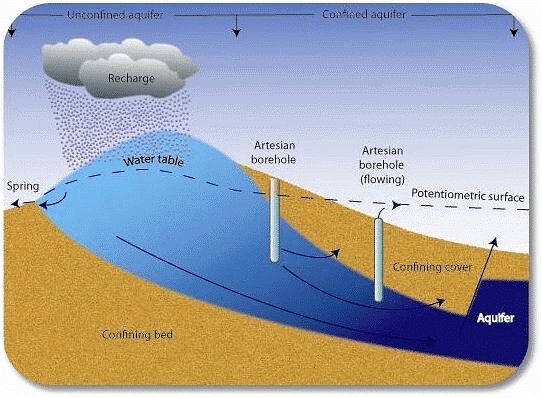UPSC Exam > UPSC Notes > Civil Engineering Optional Notes for UPSC > Unconfined Aquifers
Unconfined Aquifers | Civil Engineering Optional Notes for UPSC PDF Download
What is Unconfined Aquifer?
- An unconfined aquifer refers to a water reservoir consisting of groundwater, precipitation runoff, and contributions from nearby streams, with its surface directly exposed to the atmosphere. Unlike confined aquifers, their water levels are influenced by atmospheric pressure, leading to fluctuations. Due to their nature, unconfined aquifers replenish more rapidly.
- In the realm of trenchless technology, dealing with unconfined aquifers presents various challenges. These aquifers typically contain layers of clay, sand, and gravel, complicating the dewatering process required for drilling or microtunneling activities. Managing water levels becomes crucial, as excessive groundwater can hinder construction efforts and compromise project integrity.
- Unconfined aquifers originate from the infiltration of groundwater or surface runoff through the permeable layers of rock and soil, ultimately collecting within impermeable rock formations. Unlike confined aquifers, these unconfined aquifers have their upper water surface, known as the water table, directly exposed to atmospheric pressure. Consequently, the water table fluctuates more prominently, making it susceptible to the impacts of drought conditions.
Key characteristics defining an unconfined aquifer include:
- Absence of complete confinement by impermeable materials on all sides.
- Exposure of the water table to atmospheric pressure, allowing for fluctuations in response to environmental conditions.
Furthermore, the National Groundwater Association highlights that unconfined aquifers are prone to water losses due to processes such as plant uptake and evaporation, further influencing their dynamic nature and water availability.

Encountering Unconfined Aquifers During Drilling
- Unconfined aquifers primarily serve domestic and agricultural water needs.
- Due to their exposure to the atmosphere, unconfined aquifers are at greater risk of contamination.
- Construction near aquifer systems raises concerns for drillers regarding potential contamination risks.
- Unconfined aquifers often lie beneath rivers and streams, consisting of sand, limestone, and gravel layers.
- Challenges in directional drilling or microtunneling arise from soil density variations, leading to over-excavation or instability.
- Close collaboration between contractors and hydrogeologists is crucial to implementing protective measures.
- Precautionary actions may include installing protective barriers, implementing groundwater monitoring systems, and adhering to environmental regulations.
- Protecting unconfined aquifers from contamination during construction activities is essential to preserve water quality and integrity.
 Groundwater Contamination
Groundwater Contamination
- Groundwater contamination during trenchless operations occurs when fluids containing chemicals and additives inadvertently infiltrate aquifers, leading to the mixing of contaminants with the groundwater supply.
- Contaminants commonly associated with drilling and construction activities include substances like gasoline, drilling fluids, and heavy metals, all of which pose risks to groundwater quality and environmental health.
- The Environmental Protection Agency (EPA) closely monitors the use of chemicals in drilling fluids due to their potential toxicity and environmental impact. This scrutiny underscores the importance of thorough assessment by hydrogeologists to evaluate groundwater susceptibility to contamination before project approval.
- Conversely, the movement of groundwater from aquifers into trenchless tunnels can also occur, impacting the stability and composition of drilling fluids. This influx of groundwater may dilute or destabilize the fluids, leading to challenges in maintaining control and stability during construction.
- To mitigate these risks, comprehensive investigations into aquifer locations and groundwater flow patterns are essential. These assessments help ensure that construction activities do not compromise the integrity of aquifers or nearby water bodies.
- Hydrogeological reports play a critical role in providing essential data on groundwater dynamics, including fluctuations and flow patterns. This information informs decision-making processes regarding the implementation of dewatering measures and other protective strategies to safeguard groundwater resources during trenchless construction.
The document Unconfined Aquifers | Civil Engineering Optional Notes for UPSC is a part of the UPSC Course Civil Engineering Optional Notes for UPSC.
All you need of UPSC at this link: UPSC
|
350 videos|464 docs|2 tests
|
|
350 videos|464 docs|2 tests
|
Download as PDF

|
Explore Courses for UPSC exam
|

|
Signup for Free!
Signup to see your scores go up within 7 days! Learn & Practice with 1000+ FREE Notes, Videos & Tests.
Related Searches

















